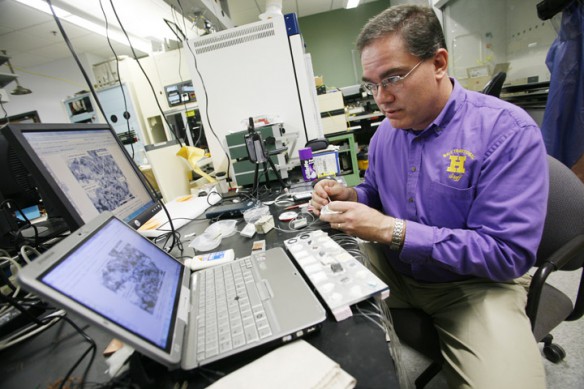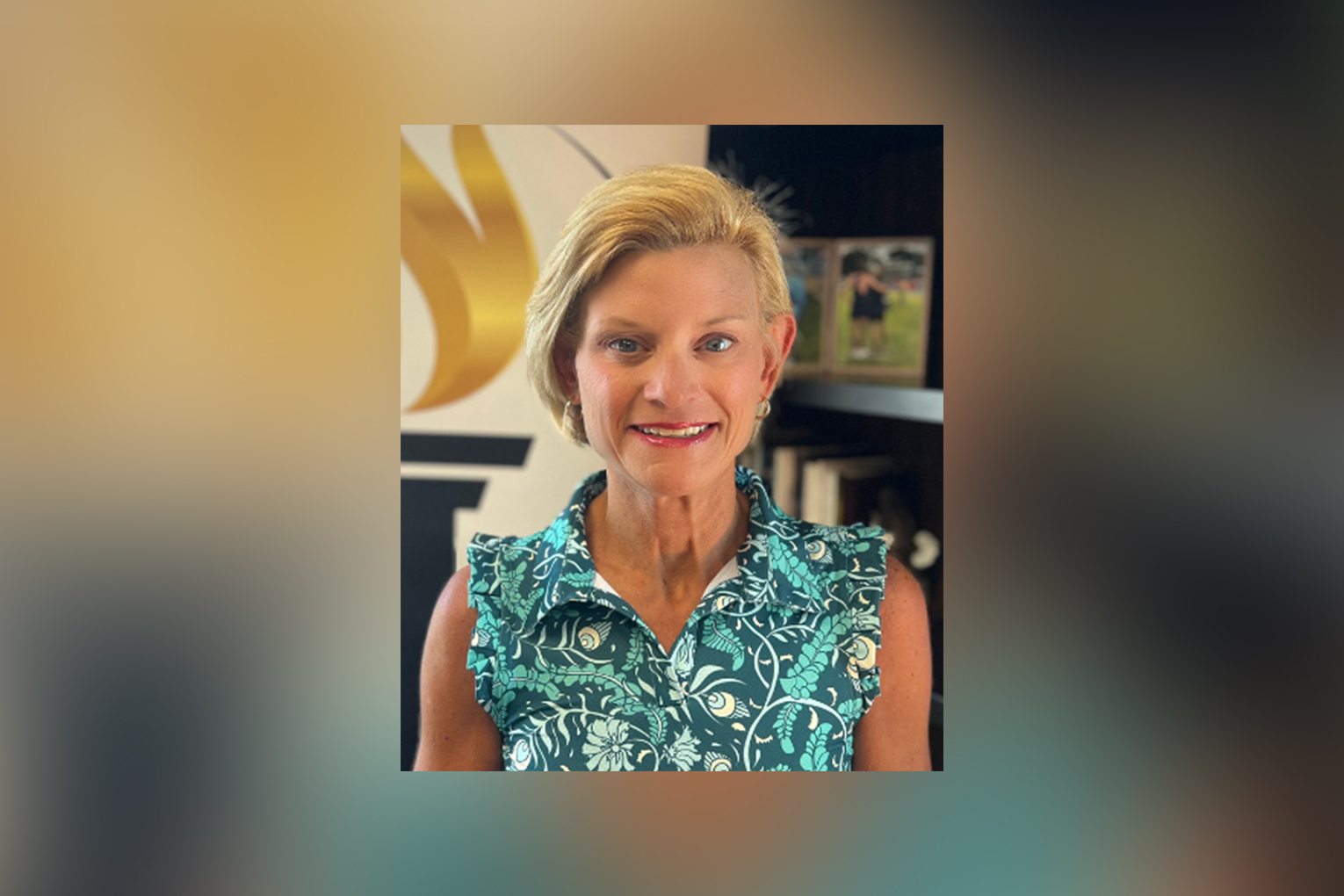
Louisville Male High School (Jefferson County) teacher Jeff Wright experiments with building Knudsen pumps during the High School Teacher Fellowship Program at the University of Louisville.
By Matthew Tungate
matthew.tungate@education.ky.gov
Heather Packard spent four weeks of her summer vacation driving four hours a day to the University of Louisville.
What inspired the Bellevue High School (Bellevue Independent) biology, forensics and integrated science teacher to make the daily trek? Her desire to get hands-on experience working with nanotechnology.
“If I’m not continually learning personally, how can I take my students beyond what we’ve always done? Do I want to kind of change what I do in my classroom in theory, or do I want to be a better teacher because I am growing personally?” she asked. “I’m here because I like it. I want to continue to learn and I feel it makes me a better teacher. Even if I don’t take any techniques from that laboratory directly to my classroom, I can’t help but take the experience. Continuing to learn helps my students learn.”
In doing so, Packard may one day contribute to the treatment or cure of cancer – either through inspiring one of her students or through her own research.
Packard is one of seven Kentucky teachers who participated in the High School Teacher Fellowship Program sponsored by the National Science Foundation in conjunction with the Department of Bioengineering at the University of Louisville and Center for Biomedical Engineering at the University of Kentucky. Participants spent four weeks conducting hands-on research at either UofL or UK. The $3,750 fellowship is paid for by the Experimental Program to Stimulate Competitive Research (EPSCoR).
Shamus McNamara, associate professor of electrical and computer engineering at the University of Louisville, is co-coordinator of the fellowship, in its third year, with Hainsworth Shin, assistant professor at the Center for Biomedical Engineering at the University of Kentucky.
McNamara, whose office includes an Albert Einstein action figure, said the teachers do real research whose outcomes are not predetermined. Part of the fellowship is teachers learning new skills, concepts and equipment.
“We’re not going with a bunch of canned experiments,” he said.
For instance, Jeff Wright worked in McNamara’s nanotechnology lab – which looks more like a machine shop with its hacksaw and drill press. The Louisville Male High School (Jefferson County) physics and physical science teacher built a Knudsen pump. While that may sound complicated, to Wright it means taking a porous material, sticking it on top of a thin plastic tube with a drop of water in it and then running the tube through a thin piece of metal.
Wright’s goal was to see what material at the top attracted the drop of water the fastest. McNamara had used silica, but Wright wanted to use cheaper materials – something he could replicate in his classroom. So he tried diapers, coffee filters, concrete, brick and coal, among other things, much to the amusement of McNamara and his graduate students.
“They laughed at me, but all of a sudden that piece of Styrofoam worked awesome,” Wright said, adding that shaving cream worked well, too.
To McNamara, the pump may end up being a battery-less pump to deliver medicine to a patient using only his or her own body heat. To Wright, “What I’m thinking is, ‘How can I take this back to the kids and make them think?’
“I want my kids to do this now,” he said. “Every kid could glue a piece of substance to a piece of metal and test it.”
There are so many variables to test, Wright said. Besides the material, students could test temperature differences and size of the pores in the material.
“I’m really hoping they will be able to use the chemistry that they learned last year, learn the scientific method, plus put some physics in it with gas laws, and put it all together and maybe write a nice little paper for their portfolio,” he said.
Cindy Harnett, associate professor of electrical and computer engineering at UofL, said seeing the teachers deal with their financial constraints has been eye-opening.
“I guess I’m learning just how low-budget we have to go,” she said.
She worked with Chris Williamson, a mathematics teacher at Crittenden County High School. He worked on a project to help make sensors less expensive. Williamson wanted to make a lot of the sensors to see what percentage survived the production process as an example of statistics for his classes, Harnett said.
Williamson designed the sensors with different widths, sizes and shapes of the wires, she said, which adds value to his part of the research.
“If he wasn’t doing it, we would not be doing as many different variables,” Harnett said. “We would be trying some processes that other groups have used and just trying to bring them into our lab without experimenting very much, seeing if there is any optimization we can do, because it is very labor-intensive to do all of these geometries. We just wouldn’t have time for that.”
Harnett said Williamson also asked the same questions he expects from his students – why should they care about this?
“I think he’s adding a lot to our lab through the perspective of what is important to explain to students about what we’re doing,” she said. “We need people to ask those questions every summer.”
The teachers who earned the fellowship this year are very accomplished. Wright, for instance, is a former Kentucky Teacher of the Year and winner of the Presidential Award for Excellence in Science. Haridas Chadran, a Belfry High School (Pike County) physics and chemistry teacher, has a PhD in physics. Marlon Francis, a Seneca High School (Jefferson County) physics and integrated science teacher, is an Amgen Award for Science Teaching winner.
But Chadran said credentials aren’t the most important attribute to receiving the fellowship.
“Passion is very important,” he said. “If teachers want to have a passion to do these sort of things, and we want to improve, anybody can do it.”
Teachers shouldn’t feel intimidated to apply for the program, said Packard, who was researching ways to isolate cancer cells using magnetism.
“There is really nothing going on in that laboratory that isn’t a learning experience,” she said. “It’s less about research and it’s more about teaching how to do research. You could come in with pretty much no lab experience and be comfortable.”
Wright said he’d never heard of a Knudsen pump before he walked into McNamara’s lab. A week into the fellowship, he was already working on lesson plans using them.
“I’ve heard about nanotechnology, but I just never thought I could apply it in the classroom,” Wright said.
FOR MORE INFO …
Shamus McNamara, shamus.mcnamara@louisville.edu, (502) 852-6704,
Hainsworth Shin, hy.shin@uky.edu, (859) 257-3783








Leave A Comment